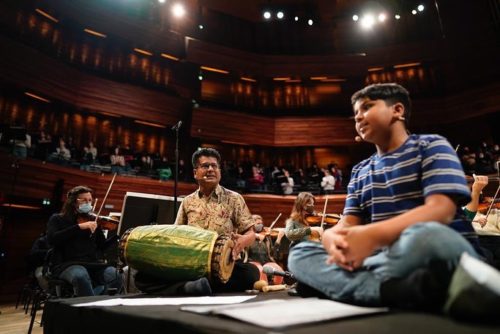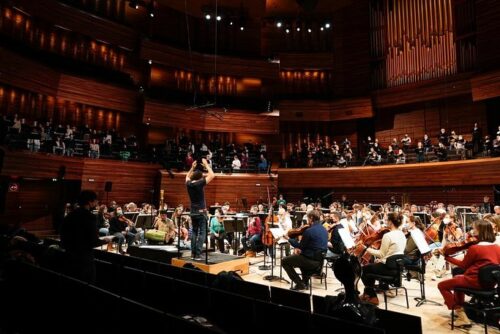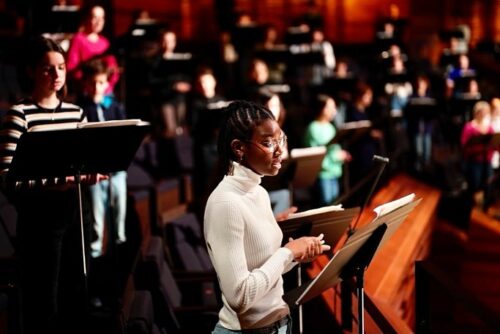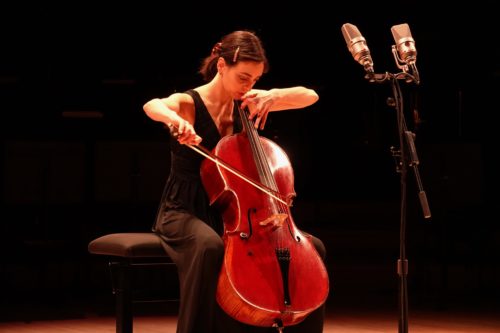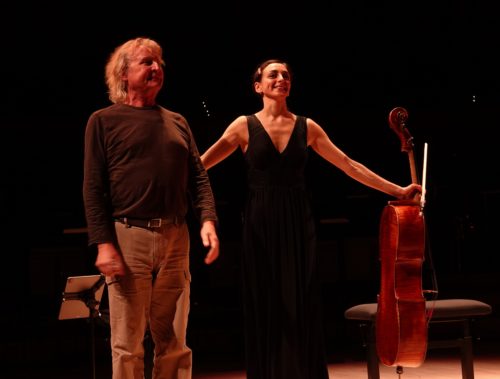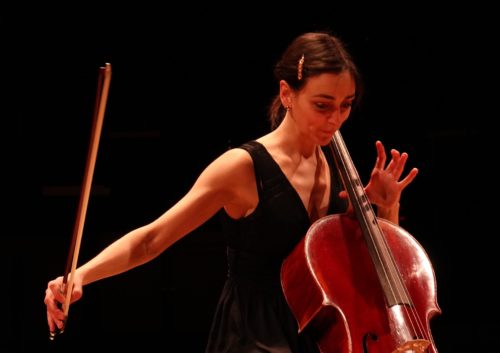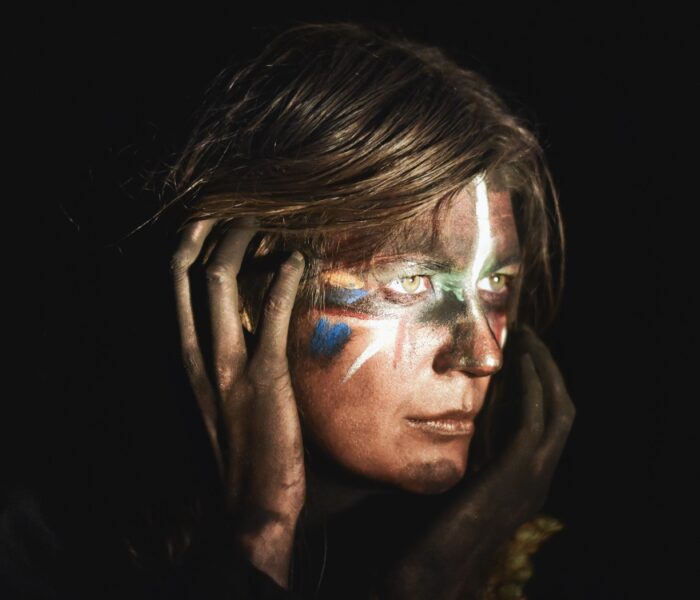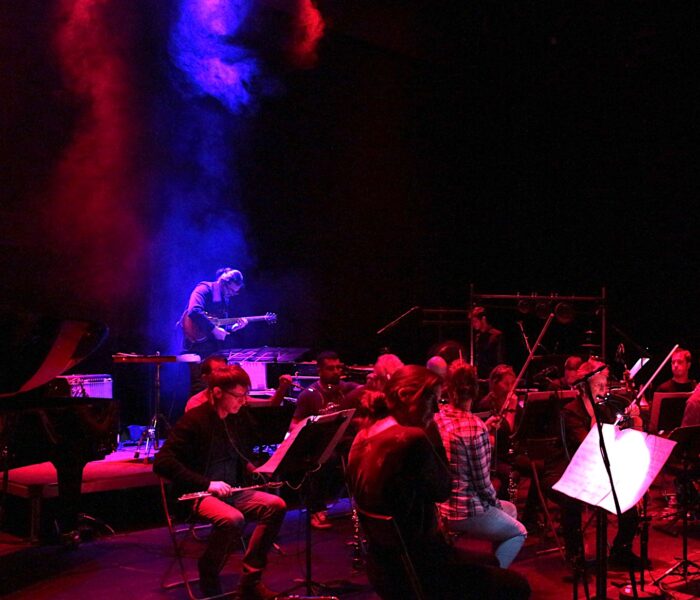A good turnout at the Maison de Radio during the weekend of the Présences festival, which this year honoured the composer Tristan Murail, a major figure of the spectral movement born in the 1970s in reaction to the serial school. Seven concerts are on the programme, ranging from solo recitals to the most impressive orchestral displays.
The Saturday evening concert at the Auditorium will be remembered for the charismatic Alexandre Bloch, who led the Orchestre National de France, the mixed choir and the Maîtrise de Radio France on the upper floors, the organ and the soloists. This is the challenge launched by Sébastien Gaxie in his Cosmic Dance, an inter-global sound design in a playful as well as lyrical mode, crossing Western and South Indian culture. Fascinated by the Hindu rhythmic language that he discovered via social networks, Gaxie builds his sound edifice on a few formulas of Konnakol, this art of rhythmic recitation from South India, of which Alexandre Bloch gives us an overview in his sympathetic listening keys. Gaxie has summoned B.C. Manjunath and his mridangam drum for this purpose. The master sits cross-legged in front of the orchestra, his son (or disciple) at his side. He is the guarantor of the rhythmic formula chosen and galvanises everyone, including the orchestra, during the fifteen minutes of this "celebration". An ode in honour of Shiva, mixing Indian, French and English languages, reaches us from the balcony while the choir sings with the organ the stanzas of Lamartine's Harmonies poétiques. The orchestra doubles, highlights and colours the voices in a rhythmic-melodic maelstrom that Alexandre Bloch supervises with his firm and efficient gesture.
The Maîtrise is on stage, with its conductor Sofi Jeannin, in the second creation of the concert, that of the composer Diana Soh Tu es magique. The seven sequences of the piece are like pages turned from a picture book, renewing the soundscape and the words of the text written by the composer herself: the sounds of footsteps, mouths, murmurs, finger snaps, etc. are all noisy evocations that call upon the voice, gesture and body of the young singers to whom the score leaves a space of freedom in the interpretation. Tu es magique is a message of love and an ode to life full of freshness and invention.
In contrast to the plethoric orchestra ofAllain Gaussin 'sAnnées-lumière (1993), which plays on the spectacular surges of sound matter, Samir Amarouch 's Analogies calls for only thirteen instruments arranged symmetrically in relation to the conductor. The composer is interested in the transition between natural sounds and digitised sounds through the spring of the extended playing techniques used to imitate electronic sounds.
In Tristan Murail 's Le partage des eaux (1997), which crowns the evening, the sounds analysed by the digital tool come from natural phenomena such as the wave breaking on the shore and the surf. The sound phenomenon is familiar to this native of Le Havre for whom the sound of the sea was a daily occurrence. As in all the works of this period, the sounds of a synthesizer are added to the instruments of the orchestra and merge with them. The sound images are lush, powerful and enchanting under the expressive gesture of the conductor and the exemplary involvement of the 'National'.
Electricity in the air
It is 10.30 pm and the 104 studio is almost full for the fourth concert of the day, welcoming the guitarist Giani Caserotto (performer, composer and improviser as well as founding member of Cabaret contemporain) in a programme combining pieces by Fausto Romitelli, Tristan Murail and his own composition given as a world premiere.
We are surprised by the restraint of the performer's gesture in Trash TV Trance (2002) by the late Fausto Romitelli, whose sonic effects and unusual modes of play seem to call for visual performance. Playing with the parasites of sound, Romitelli combines guitar and saturation, noise and distortion, impacts and repetition in an uncompromising 'rock attitude'. The electric instrument did not escape the attention of the young Tristan Murail, who wanted to produce live electric sound. Vampyr! is written for Claude Pavy, in the energy of rock and the model of "the saturated sound of tube amps", the composer tells us. The writing explores the sonic spectrum, from the deep bass of the guitar to the electrifying shrillness of the treble. Like the electric guitar, ondes Martenot fascinated Tristan Murail, who played them early in his career as a composer. Les nuages de Magellan (1973) - two small galaxies close to our own, Murail points out - features two ondes Martenot (often associated with celestial evocations), an electric guitar and percussion. The piece is performed tonight with great finesse and concentration by Augustin Viard and Cécile Lartigau (two former students of the Paris CNSM class taught by Nathalie Forget) sharing the stage with Giani Caserotto and percussionist Julien Loutelier.
By Giani Caserotto, Les temps électriques, commissioned by Radio France, is a sort of concerto for guitar and eight instrumentalists, all chosen for their singular ability to play and improvise on their instrument. The current flows between the solo guitar, which is very present but not ostentatious, and the eight protagonists, a sort of satellite within the sound galaxy, which is at the same time an area of exchange, a space for synergy and a place for improvisation.
Solo
It is at the Auditorium that Marie Ythier gives her recital, a place that she says is inspiring because of its beautiful setting and comfortable acoustics. She is at ease, very concentrated and in the fullness of her abilities to tackle a demanding programme including two pieces by Tristan Murail. The long title of the first, C'est un jardin secret, ma sœur, ma fiancée, une source scellée, une fontaine clos... is a quotation from theSong of Songs; the piece is short and appropriate, originally written for the viola: music of the intimate, tender and poetic, which solicits acute listening. Like the first, Murail's second piece, of a completely different scale, is played by heart by the performer. A cornerstone of the cello repertoire of the XXᵉ century, Attracteurs étranges (1992) was written for the 70th birthday of Iannis Xenakis. The writing is a spectral analysis of a fundamental sound on which the cellist's bow stubbornly comes up against: the elegance of the lines that rise in a spiral captivate the listener, as does the sumptuousness of the colours obtained through very diverse playing techniques; sovereign in this highly virtuoso piece, Marie Ythier draws all the sinuosities with an unctuousness of timbre and unequalled flexibility of bow.
Among the other works on the programme, we will first focus on Curve with plateaux, a score by the British composer Jonathan Harvey exploring the expressive capacities of the instrument. The writing sweeps across the three registers of the cello, from low to high, an area in which the cellist excels, revealing the finesse of liminal sounds obtained with astonishing precision and delicacy. A pluck on the 3rd string of the cello makes the ground resonate like a small gong in Riff, where the composer Bastien David takes malicious pleasure in diverting the instrument from its function; the music shatters under the cellist's rapid gesture. The Chinese composer Shuhan Hu (a former student of Tristan Murail) is inspired by the playing modes of traditional instruments in her country, with ornamentation, pitch fluctuations and noisy instances. In Les fleurs de pêcher s'épanouissent à travers les fissures des os (Peach blossoms bloom through the cracks in the bones ), which is part of the field of spectral music and is based on the narrative framework of a poem, the flexibility of the bow and even of the performer's wrist is exercised. Rozalie Hirs' Article 10 [prisme] is less convincing, more didactic, even if the plastic beauty of the "spectral melodies" operates under Marie Ythier's beautiful bow.
Nice closing gesture
A rare work revealed to the Parisian public, three world premieres and the presence on the podium of the American conductor Brad Lubman, this was the luxury of the closing concert of the Présences festival on the stage of the Auditorium where a Philharmonic Orchestra in great form was deployed.
Two conductors are placed side by side (Brad Lubman and Edo Frenkel), each leading a part of the orchestra in Jonathan Harvey's Timepieces (watches or clocks), a piece from 1988 given its French premiere. The composer's intention is to blur time and disturb our perception by bringing several temporalities to life at the same time. The experiment is masterfully carried out, the orchestration chiselled and the sound situations constantly renewed (there are three movements) in a very alert manner that is not without humour.
On the creation side, if Samir Amarouch's Ensauvagement does not fully convince us, the composer at least knows how to grab our attention in the particularly powerful last minutes of his piece. Autre nature for orchestra and electronics by Jean-Luc Hervé is divided into two parts. The first phase, which is essentially acoustic and struggles to find its momentum, is somewhat boring. Hervé surprises us more in the second part, where the listening sources are multiplied by small loudspeakers scattered among the audience. This phenomenon of "sound germination" is not new in his production, but it is clear that the magic of the device (controlled by the forces of the CIRM) and the pleasant sensation of being surrounded by the sounds of nature still work.
The title refers to Chopin, but the orchestral technique looks to Liszt; this is what Tristan Murail tells us aboutŒil du cyclone, his second piano concerto and world premiere, which he subtitles fantaisie-impromptu. First of all, it should be noted that he does not use electronics but transfers some of his data to the instrumental writing. The compositional gesture is particularly liberated and the inspiration abundant, in the fluid and voluble piano part entrusted to François-Frédéric Guy and the deployment/scintillation of the orchestra within which frequent instrumental solos are heard. Olivier Messiaen is also celebrated in this very surprising homophonic sequence that prepares the pianist's cadenza. Associated with the crotales that irradiate the sonorities, it is the pianist who closes the score, in the liminal high notes of his instrument.
Michèle Tosi



)
